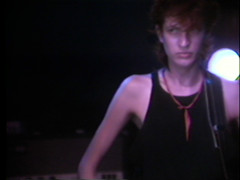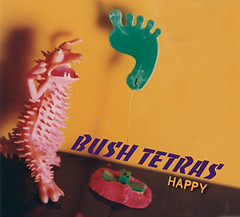Pat Ivers and Emily Armstrong continue sorting through their archives of punk-era concert footage as it’s digitized for the Downtown Collection at N.Y.U.’s Fales Library.
“You don’t need a million to look like a million!” So went the tagline touting Ritz Furs in a ubiquitous late night commercial that ran throughout the ’70s and ’80s. Ladies were urged to sell their skins or buy them second-hand at a fraction of the price because, like the man said, “Some women ski in St. Moritz; other women just look that way.”
Cynthia Sley, lead singer of the Bush Tetras, got to live the dream. One night, she found a full-length fur coat lying on an East Village street. She picked it up, dusted it off and the next day sold it to Ritz Furs. The cash allowed her to live another month in New York, pursuing her art instead of a paycheck.
The choice of art over commerce has been a thread running through the history of the Bush Tetras. A staple on the New York music scene since 1979, their sound has been described as both danceable postpunk and no wave, two utterly different styles that they somehow made work together. The original Bush Tetras lineup consisted of guitarist Pat Place and keyboardist Adele Bertei, both freshly departed from The Contortions, as well as bassist Laura Kennedy, who had been their roadie. Dee Pop, a drummer with a taste for jazz as well as punk, rounded out the mix.
When Adele left after just one gig, the band turned to Cynthia, a pal of Laura’s from back in Cleveland. Dee recalls, “She had been hanging around during rehearsals and at first, we asked her to just recite our lyrics while we played behind her. We liked it so much, we asked her to be our vocalist.” With an all-female front line and a male drummer, they were unique. The sound was dissonant and rhythmic like The Contortions, but there was a different and dark, feminine twist. Cynthia sang/chanted the lyrics in a trancelike drone that was mesmerizing and sexy while Laura kept sinuous funky time on the bass. Pat’s
sliding screeching guitar found a counterpoint in Dee’s tribal rhythm on drums.
There were no girly girls here; they were the anti-Gogos.
Watch them at Danceteria in 1980, performing at one of their earliest gigs.
Cynthia recalls, “I had the lyrics and song list taped to the microphone. I was so terrified, I could barely look at the audience.”
We couldn’t tell: we just thought they were great. That song, “Too Many Creeps,” made the Billboard dance charts and became a club anthem. They were shocked. “We never thought ‘Creeps’ would hit the charts and become popular,” Cynthia said. “Funny, how we wrote the songs in our little rehearsal cave — just so insular and unconscious.”
They began to play out more locally and then at larger venues. When the Bush Tetras opened for The Clash, that band’s drummer, Topper Headon, offered to produce an EP, “Ritual.” College radio embraced “Can’t Be Funky” from that record, but by 1983, the band began to dissolve. Laura left first, followed by Dee and soon it all ended. The band reformed in 1995, adding Julia Murphy on bass when Laura opted to stay in Minneapolis. They recorded an LP in 1998, “Happy”, which was finally released this month.
The band never really stopped playing, gigging in fits and starts: never for the money, always for the feeling; a feeling to which they kept coming back. As years went on, both Pat and Cynthia split their time between music and art, each working in photography (Pat in New York and Cynthia in L.A.). Cynthia also had a band, Command V with ex-Raybeat Pat Irwin.
As for Dee, “I gig constantly. I still have a hard time with the idea of not actually performing all the time,” he said. Besides the BTs, he has a punk blues band, Private World and an improvisational jazz group,
Freedomland.
The band’s original bassist, Laura Kennedy, passed away in 2011 from liver failure. In a blog she kept in the final days of her illness she wrote, “Having lived through the eighties….we keep going, and going and going. I defy you to tell me that all of us weren’t defined by that moment in time that we shared. We were blessed to come together in this life at a time that defined the End of a Century.”
She knew that art always beats commerce.







